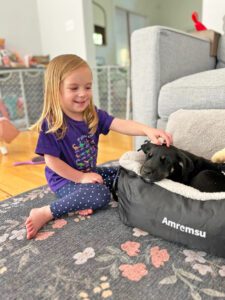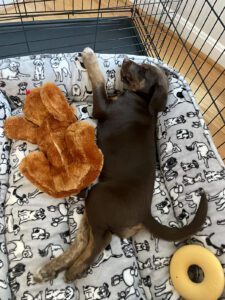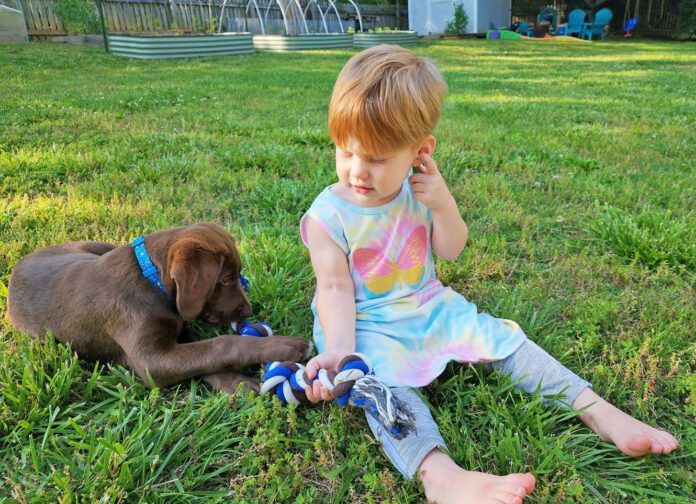Everybody knows they need to prepare their home for a puppy’s arrival, but often parents don’t realize just how much they need to prepare their children for that moment. Puppies and kids go together well, but it takes prep work with both the child and the puppy.
Puppies jump! They have sharp teeth! It’s key to talk to kids ahead of time about what puppies can be like — and to put structures and rules in place to protect all the vulnerable parties from unintentionally hurting or scaring each other.
Creating the right environment, routine, and habits in those first intense months is worth every bit of effort, because few things in life beat the puppy-and-kid-growing-up-together experience. Here are eight keys for helping canine and human kids to go beyond just getting along and end up bonding for life.
-
GET IN THE ZONE
First step: parental mindset. It’s demoralizing to be thrown off guard by challenges day after day. (“Mom! She chewed my doll!” “Dad! He knocked Jimmy over!”) Instead, take a deep breath and expect those issues. Not only does that help you psychologically gird yourself for a certain level of frustration, but it will result in preparation that means far less of the unfortunate stuff will actually occur.
-
TEACH YOUR CHILDREN ABOUT PUPPIES

The adults are not the only ones who need psychological prep. Kids need to be taught that the puppy is just a little kid like themselves – and one of a puppy’s favorite things to do is to play The Puppy Game. This is the beautiful chase/jump/bite/wrestle game she played endlessly with her littermates before you brought her home. Now the small humans in your home are the closest thing she has to the canine friends she misses so much – they even squeal like puppies! Kids are usually sympathetic to learning that their puppy badly misses her sibling playmates and the fun games they used to play all day, every day.
Even when they understand that, most kids need reminders to help them be their best selves around the puppy. Practice these sentences:
- She’s just a baby.
- We are her teachers.
- She is doing all the things that are normal for puppies to do! We need to teach her what humans like to do.
- I know those teeth hurt, but she didn’t mean to hurt you! Puppies play like that with their very favorite littermates. We need to help her find a different way to play with you.
-
USE GATES, PENS, & CRATES

Having the tools to easily separate kids and dogs on a regular basis is the single biggest predictor of household happiness in the puppyhood months. Puppies and young kids simply cannot hang out together without being managed carefully – period! Yes, I know that this might be devastating news for parents who thought that a puppy would help keep kids off screens and playing in a wholesome manner while parents can focus elsewhere, but, nope. Not yet. One day!
If you want to reach that “one day” sooner, you need to do the groundwork by refusing to let bad habits get established. And it’s certain that unsupervised kid/puppy interactions will result in the puppy playing The Puppy Game – and a kid coming crying to you. There is a lot to teach children about how to act in a way that won’t draw out The Puppy Game in the puppy, but while that’s a work in progress, the key is to have quick separation options at your disposal. Do not hesitate to fill your house with them all. Crates, pens, gates, sofas moved just so, etc., are valuable tools for keeping all the kids safe and separated when you’re not able to actively supervise their interactions.
-
GET MORE CHEW TOYS (NOPE, YOU DON’T HAVE ENOUGH)

Without even seeing your set-up, I’m going to tell you this: You don’t have enough chew toys, and/or they’re not in the right places. “Huh? My basket is overflowing!” I know. But that’s just it, they’re over there in the basket, and your kids need to be able to reach them RIGHT NOW, because the puppy is about to greet your kindergartener by jumping up and sinking in some teeth.
For people who love to keep the house and yard straightened up all the time, this is challenging news indeed. But your kids must be able to reach out whenever they’re going to encounter the puppy and grab a long fluffy fox, a braided felt rope, or a big squishy ball. They need to be able to – over and over and over – teach the puppy that teeth go on the toy, not on the kid. It may be hard for kids to remember to set themselves up for success this way, which is why the adults have to make it easier by keeping those toys easily within reach.
-
SET AND TEACH THE RULES TO YOUR KIDS
Creating clear, easy-to-remember guidelines for how to interact with the puppy is a lifesaver, because normal kid behavior includes a lot of things that will bring out the worst in the puppy. Save yourself a lot of trouble by having a family meeting (or two, plus a quiz!) to discuss these guidelines:
- Let the puppy choose whether to interact! If there were only one rule, it would be this one. This is not a stuffed animal to be grabbed, picked up, trapped in a long hug, moved here and there, and argued over. Show the kids how to entice the puppy instead, using squeaky toys, happy voices, and treats. If you want your future adult dog to be safe around kids, make sure your kids treat this impressionable puppy with respect.
- Find your slow body. A running/jumping human creates a running/jumping puppy.
- Use your quiet voice. High pitched, loud noises get a puppy aroused, and aroused puppies jump, chase, and use their teeth to interact.
- Sit on the floor if you want to hold the puppy. In my house, kids are criss-cross applesauce on the floor when they hold my foster puppies. If you feel this is Draconian, I will tell you stories of dropped puppies with broken legs, or of dogs who growl at the approach of their own child. Kids love to walk around the house holding a puppy – and almost all puppies hate that.
- Let sleeping dogs lie. Puppies need a lot of sleep, and they should be left alone to get it. This can be really difficult when you have a very mouthy/jumpy puppy, because sometimes kids only feel safe approaching the pup when he’s sound asleep on the floor. Promise me at least this: If the pup moves away, respect that choice immediately.
- Play fair. Dangling something in front of a puppy without ever actually giving it to him teaches him not to trust you. That’s the opposite of what we want to teach. Use the Golden Rule: Play the way you’d want to be played with.
- Respect the crate. It must be the puppy’s safe, quiet, private refuge. No climbing in. No surrounding a pup who wants to be alone.
-
MAKE PUPPY PLAYDATES
If you’ve ever watched puppies with their littermates, you know that life is one long version of The Puppy Game. Reasonably enough, that’s what puppies want to do with us, since we took them away from their playmates. It is utterly unfair to then spend every day saying, “No. No. No. No. No.” Instead, it’s on us to help them find a new friend who’ll love to wrestle, bite and chase.
People new to puppyhood often feel awkward or nervous about asking neighbors for a puppy playdate. We experienced puppy people say: Nothing will improve your puppyhood experience faster than finding an awesome puppy friend nearby. It will match your puppy’s over-the-top energy, give him a healthy outlet for his biting and jumping, and build his doggy communication skills which will keep him safer in encounters with other dogs. (Here are tips on how to supervise that playdate.)
If I could conjure up the perfect scenario, I’d say start every day with a 20-minute cup of coffee in a fenced yard with a neighbor, and maybe add another 20-minute session right before the kids come home from school in the afternoon. That may be beyond the ability of many new puppy owners, but do what you can!
-
ORGANIZE STRUCTURED TOGETHERNESS
Free play between kids and puppies often ends in chaos, and that’s not a habit we want them to practice. Having a handful of activities on tap that put a bit of structure on the scene is key. Here are a few examples:
- A walk is a great option. Heading out on an adventure together can be a perfect way to bond. All parties are interested in the surroundings, so they won’t be 100% focused on each other. Maybe the kids are on a bike or a scooter. The pup is on a leash so it’s easy for the kids to pop out of range if The Puppy Game threatens to start. Bring a treat pouch (always) and have the kids reward when the puppy responds to her name with eye contact.
- Playing the recall game is a two-fer: It’s fun and it teaches the puppy that it pays off to come when called. Just get in a circle and take turns calling your pup with a big, fun, cheery, “Come-come-come!” When puppy spins and runs to the person who called, they deliver a treat. Even tiny kids can play this game, and it teaches the pup to listen to everyone in the family.
- “Find it” can be shockingly helpful. First, the adults need to teach the pup that the magic phrase “Find it” means it’s worth looking on the ground because they’ve just tossed something there. Once pup is enthusiastically seeking out those bits of kibble, this becomes an incredibly useful game. Keep a ceramic jar of kibble where the kids can reach it, and teach them to toss a bit of kibble and say, “Find it!” Pup will snuffle after the treat and then turn back to see what’s next. Kid says: “Find it!” and tosses in a different direction. Repeat, repeat, repeat. As you advance, the pup sits to start the next round. (Jumping or mouthing puts a stop to the game.)
- Training is the best game of all when kids are old enough (or the right temperament) to take part. Good positive reinforcement training should feel like a fun game to the dog, and for the right kid it can be a wonderful thing to do together. Parents need to be totally on it, though, in terms of deciding what that should look like. If your puppy is just learning “sit,” but you let your 2nd grader come in and demand sits in a big voice without rewarding at the right time . . . you’ve just set your training back. (Some kids love telling dogs what to do, so it’s key to emphasize that we’re teachers, not drill sergeants.)
-
CREATE A NAP-FILLED ROUTINE
Setting up a daily routine is hugely helpful in fostering better interactions between kids and puppies. There are going to be times where either a child or the puppy is too wound up (or too tired) to be at their best. Instead of trying to react in the moment to those constantly shifting winds, you can overlay a structure that stacks the deck in your favor.
Building puppy naps into the routine is critical! Often the puppies who are the most jumpy/bitey are the ones who are not getting enough sleep because of their active household. Young puppies should be sleeping at least as much as they’re awake for the first few months! (i.e., awake from 7–9; asleep from 9–11.) Just like toddlers, many puppies think they don’t need a nap, so they don’t take one by choice. This is where a nice, quiet crate comes in, maybe with a box fan on or classical music playing to mask household noise.
To find the right routine, start with your family schedule, add in the natural rhythms of your puppy, and come up with a daily outline for when meals, walks, playdates, indoor training sessions, outdoor fetch and tug, and nice big naps will typically take place.
Then adjust as necessary! If your pup is over-the-top when your kids first come home from school, experiment with your routine. Does she need a giant nap before being her best with the kids? Or does a big walk or a 20-minute romp with the neighbor pup take the edge off and help her be ready to play without all the teeth?
Mind you, this kind of careful planning won’t be necessary forever! But in the beginning, while you’re teaching good habits about how to act around each other, aim to put kids and puppies together when they’re both at their best.
PUPPIES AND KIDS REALLY ARE THE DREAM
This list of suggestions could have you throwing up your hands and saying, “Hey! I thought puppies and kids were a natural match!” They absolutely are – when they’re set up for success. For a child, there’s nothing like growing up with a friend at home who loves you unconditionally; for a puppy, there’s nothing like a playful, snuggly kid who has all the time in the world for you. And from a parent’s perspective, it’s a beautiful thing to get to witness for years and years . . . so a few months of this focused management ends up being a drop in the bucket on the way to creating the dream.






